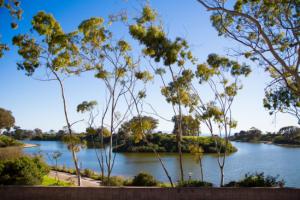Content:
In conjunction with the Cheadle Center for Biodiversity and Ecological Restoration (CCBER), the Santa Barbara County Fire Department has tentatively scheduled a one-day prescribed burn at the UCSB Lagoon, near Campus Point.
Approximately a half-acre of grassland and coastal sage/buff scrub will be burned sometime during the week of August 6-10.
The burn is part of an ongoing management effort to control non-native grasses and establish native bluff scrub vegetation. Building on successful past burns, this treatment will be conducted on a day within the burn window with the least amount of fog in order to generate enough heat to reduce the viability of the non-native seed bank, and on a day with the best conditions for dispersion.
This year’s marks the seventh prescribed burn implemented on Lagoon Island since students of Carla D’Antonio, a professor of evolution, ecology and marine biology and of environmental studies, in 2007 demonstrated that adding supplemental fuel effectively eliminated the seed bank of the invasive grass known as “rip gut brome.”
“Working with County Fire and the UCSB fire marshal, these one-half-acre fires are contained within a cleared ring and monitored until the embers are cold,” said Lisa Stratton, CCBER’s director of ecosystem management. “By clearing the monoculture of dried annual grass that arrests natural succession, this management process allows a high diversity of wildflowers and native coastal sage scrub to become established. Walk around the lagoon any time of year and you’ll see a wide variety of flowering plants that support birds, butterflies and other insects and restores our heavily impacted coastal habitats for generations of students to appreciate.”
As conditions permit, the burn is scheduled to begin in the late morning or early afternoon and conclude by 4 p.m. It will be conducted when meteorological conditions are highly favorable to direct smoke away from populated centers.
Due to changing winds and weather conditions, it is difficult to predict which areas of the county, if any, may be affected by smoke from the burn. Individuals who smell smoke should take precautions and use common sense to reduce any harmful health effects. If you can smell smoke or it is visible in your area, avoid strenuous outdoor activity and remain indoors as much as possible. These precautions are especially important to children, older adults and those with heart and lung conditions.
Contact Info:
Andrea Estrada
(805) 893-4620
andrea.estrada@ucsb.edu


